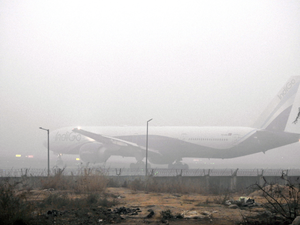Delhi airport chaos: Who is responsible for delays – Aviation Ministry or airline operators?

New Delhi, Jan 15 (IANS) Delhi’s Indira Gandhi International (IGI) Airport in the last two days has experienced significant disruptions with nearly 600 flights delayed, and 76 flights cancelled due to dense fog and poor visibility. This has caused a ripple effect across airports in the country.
As per sources, the primary reason for the chaos is the limited operational capacity of the airport’s runways.
Currently, Delhi airport has only one CAT III-equipped runway designed for operations in low visibility.
The second runway, 28/10, is undergoing re-carpeting, making it temporarily unusable. This has led to a heavy reliance on a single runway, 29/11, which is equipped to manage operations when visibility drops below 200 metres.
The runway constraints have led to delayed arrivals and departures.
On Sunday (January 14), departures were halted until 11 a.m. due to visibility below the minimum level of 125 metres.
Flights faced considerable delays, with some waiting for over two hours to be assigned parking bays for deboarding.
The CAT-III ILS is an advanced technology that enables aircraft to land with minimal visibility, making it essential for safe and efficient operations during foggy weather.
Airlines are mandated to ensure that a sufficient number of their pilots are trained and certified for CAT-III ILS landings to mitigate the impact of adverse weather conditions on flight schedules. “Yesterday (January 14), Delhi witnessed unprecedented fog wherein visibility fluctuated for several hours, and at times, dropped to zero between 5 a.m. to 9 a.m. The authorities, therefore, were compelled to enforce a shut-down of operations for some time even on CAT III runways (CAT III runways cannot handle Zero-Visibility operations),” said Union Minister of Civil Aviation Jyotiraditya Scindia on Monday.
To address the situation, Scindia outlined proactive measures.
“To mitigate the situation in the near future, following steps have been taken: @DelhiAirport has been asked to immediately expedite the operationalization of the CAT III-enabled 4th runway (in addition to the existing CAT III-enabled runway) to the satisfaction of the @DGCAIndia, in order to get approvals,” he posted on ‘X’. “Furthermore, the Directorate General of Civil Aviation (DGCA) is set to issue Standard Operating Procedures (SOP) for airlines to enhance communication and facilitate passengers during flight cancellations and delays attributed to adverse weather conditions,” said Scindia.
The MoCA also claimed that all three Operational Runways at Delhi Airport including a CAT III runway were handling flight operations as per their capabilities on January 14, however, with reduced capacity due to intense fog.
“Fog in Delhi and the intensity cannot be called UNPRECEDENTED, it happens every year. Please differentiate between Visibility, general, and Runway Visual Range (RVR) for specific runways and points on rwy. @MoCA_GoI. For Takeoff 125m needed at all points & landing 75/50m Autoland,” Amit Singh, an aviation expert wrote on ‘X’.
“What’s totally UNPRRCENDRNTED is a total Failure of @MoCA_GoI, @DGCAIndia, @AAI_Official, #DelhiAirport last but not least @IndiGo6E, @airindia in fulfil their responsibilities to the public: A collective collapse of India’s Civil Aviation infrastructure: Instead of Blame game your a collective soul searching needs to be done. The Buck always stops the very top. in this case its @JM_Scindia the Minister of Civil Aviation – maybe a little less Public Relations and more Governance is called for if you desire to head Civil Aviation next term,” tweeted Shakti Lumba, former pilot.
Earlier on January 4, the aviation watchdog, Directorate General of Civil Aviation (DGCA) had also issued show cause notice to Air India and SpiceJet following a series of fog-related delays and diversions at Indira Gandhi International (IGI) Airport in Delhi. The aviation regulatory body said that both airlines failed to deploy pilots trained for Category-III Instrument Landing System (CAT-III ILS) landings, a crucial requirement during low-visibility conditions caused by fog.
This lapse in compliance had resulted in the diversion of multiple flights, causing inconvenience to passengers and raising concerns about the airlines’ preparedness for adverse weather conditions. Meanwhile, with delays, several passengers took to social media, attributing delays upto 8 hours in departure from airport.
Even an episode of unruly misbehaviour of a passenger also came to light in Delhi-Goa IndiGo flight on January 14, who assaulted pilot after being seated in the plane for hours, due to traffic congestion and delay in take-off.
An expert said that several factors contribute to challenges during the deboarding process.
Complex rules, competitive scheduling by airlines, and airport infrastructure limitations slow down the process.
Aircraft join take-off queues based on a first-come-first-serve principle, and once doors are closed, they enter a departure sequence.
This sequence, determined by boarding status, can lead to significant delays during foggy days.
Airline officials argue for a change in the departure sequence assignment.
They suggest assigning the sequence based on the scheduled time of departure rather than boarding status.
This could streamline the process during disruptions caused by weather conditions.
After deplaning, passengers are required to return to the arrival terminal and pass through security again, causing further delays. Airlines propose allowing passengers to wait directly at the gate and board again through aerobridge or bus.
However, security officials express concerns about potential security risks associated with this practice.
The aviation experts say that the airport’s structural limitations compound the challenges.
During peak hours, Delhi airport’s Terminal 2 handles more passengers than its capacity allows. Deplaning passengers in such conditions could lead to chaos within the terminal.
Aviation experts suggest that airlines need to have contingency plans for extraordinary delays.
In the US, for instance, regulations mandate passenger deplaning if tarmac delays exceed four hours.
However, the feasibility of implementing such measures at Delhi airport remains uncertain due to space constraints within the terminals.
–IANS
ssh/pgh


Comments are closed.